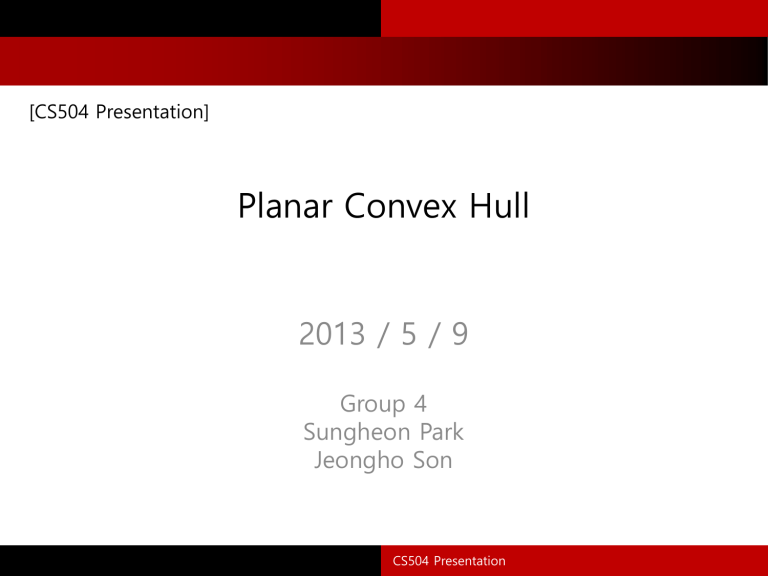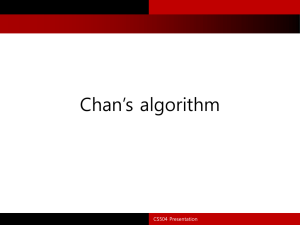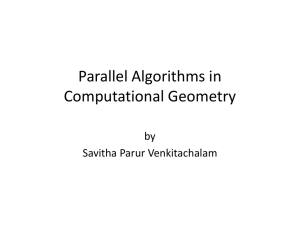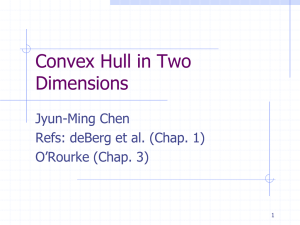Slide - Geometric Computing Lab

[CS504 Presentation]
Planar Convex Hull
2013 / 5 / 9
Group 4
Sungheon Park
Jeongho Son
CS504 Presentation
Contents
• Definition of convex hull
• Bruteforce algorithm
• Graham’s scan
• Divide and conquer
• Quickhull
• Jarvis’ method
CS504 Presentation
What is convex hull?
• Let S be a set of points in the plane.
• Intuition: Imagine the points of S as being pegs; the convex hull of S is the shape of a rubber-band stretched around the pegs.
CS504 Presentation
What is convex hull?
• Formal definition: the convex hull of S is the smallest convex polygon that contains all the points of S
• Convexity : A set
𝑆 is
convex
given any points 𝑝, 𝑞 ∈ 𝑆 any if convex combination of p and q is in
𝑆
, or equivalently, the line segment 𝑝𝑞 ⊆ 𝑆
.
CS504 Presentation
Applications of convex hull computer visualization, ray tracing path finding
Geographical Information Systems (GIS) Visual pattern matching
CS504 Presentation
Orientation test
• Given a triplet 𝑥
1
, 𝑦
1
, 𝑝
𝑂𝑟𝑖𝑒𝑛𝑡 𝑝
2
1
= 𝑥
, 𝑝
2
, 𝑝
2
3
(𝑝
1
, 𝑦
2
, 𝑝
2
,
, 𝑝
3 𝑝
3
) of three points
= 𝑥
3 𝑝
1
= in the plane, is defined as
, 𝑦
3
= 𝑥
1 𝑦
𝑂𝑟𝑖𝑒𝑛𝑡 𝑝
1
2
− 𝑥
2 𝑦
1
, 𝑝
2
, 𝑝
+ 𝑥
3 𝑦
1
3
=
− 𝑥
1 𝑥
1 𝑥
2 𝑥
3 𝑦
3 𝑦
1 𝑦
2 𝑦
3
+ 𝑥
2 𝑦
3
1
1
1
− 𝑥
3 𝑦
2
• 𝑂𝑟𝑖𝑒𝑛𝑡 𝑝
1
, 𝑝
2
, 𝑝
3
• 𝑂𝑟𝑖𝑒𝑛𝑡 𝑝
1
, 𝑝
2
, 𝑝
3
• 𝑂𝑟𝑖𝑒𝑛𝑡 𝑝
1
, 𝑝
2
, 𝑝
3
>0 : oriented counterclockwise
=0 : collinear
<0 : oriented clockwise
CS504 Presentation
Graham’s Scan
• 𝑂 𝑛 log 𝑛 algorithm
• Points are added one at a time, and structure is updated on each new insertion.
CS504 Presentation
Graham’s Scan
• Algorithm
1. Sort the points according to increasing order of their 𝑥
-coordinates, denoted 𝑝
1
, 𝑝
2
, … , 𝑝 𝑛
.
2. Push 𝑝
1 and then
3. for 𝑖 = 3 to 𝑛 do: 𝑝
2 onto stack
𝐻
.
while( 𝑠𝑖𝑧𝑒(𝐻) ≥ 2 and
𝑂𝑟𝑖𝑒𝑛𝑡(𝑝 𝑖
, 𝐻 𝑓𝑖𝑟𝑠𝑡
, 𝐻 𝑠𝑒𝑐𝑜𝑛𝑑
) ≤ 0
) pop
𝐻
.
Push 𝑝 𝑖 onto
𝐻
CS504 Presentation
Graham’s Scan
•
Analysis
– Sorting :
𝑂 𝑛 log 𝑛
– Let 𝑑 𝑖 the number of points that are popped on processing 𝑝 𝑖
, the amount of time spent processing 𝑝 𝑖 is
𝑂(𝑑 𝑖
+ 1) 𝑛 𝑛 𝑑 𝑖
+ 1 = 𝑛 + 𝑑 𝑖 𝑖=1 𝑖=1 𝑛 𝑖=1 𝑑 𝑖 is bounded by
𝑂(𝑛) since each of the 𝑛 points is pushed onto the stack once.
∴
Total time complexity is
𝑂 𝑛 log 𝑛
CS504 Presentation
Original Graham’s scan
• Initially, points are sorted in increasing angular value
• If the point is not convex (concave), it removes the current point from the perimeter list
CS504 Presentation
Divide-and-Conquer
• 𝑂 𝑛 log 𝑛 algorithm
• Recursively compute convex hulls, and merge two hulls by computing upper and lower tangent
CS504 Presentation
Divide-and-Conquer
•
Algorithm finding lower tangent
LowerTangent(
𝐻
𝐴
,
𝐻
𝐵
) :
(1) Let a be the rightmost point of
𝐻
𝐴
(2) Let b be the leftmost point of
𝐻
𝐵
.
.
(3) While (ab is not a lower tangent for
𝐻
𝐴 and
(a) While (ab is not a lower tangent to
𝐻
𝐴
𝐻
𝐵
) do
) move a clockwise
(b) While (ab is not a lower tangent to
𝐻
𝐵
(4) Return ab.
) move b counterclockwise
• Can be done in
𝑂 𝑚 , where 𝑚 = 𝐻
𝐴
• Overall algorithm runs 𝑂 𝑛 log 𝑛 time.
+ |𝐻
𝐵
|
.
CS504 Presentation
Quickhull
• 𝑂 𝑛 2 in worst case, but shows better performance in most cases
• Discard points that are not on the hull as quickly as possible.
• Begin with the quadrilateral which connects maximum and minimum x,y coordinates
CS504 Presentation
Quickhull
• Find a point 𝑐 that lies on the hull, and connect 𝑎𝑐 and 𝑏𝑐
• Eliminate the points inside hull, and recursively process for the remaining points.
• Performance depends on the distribution of the points, and how a point 𝑐 is selected
CS504 Presentation
Quickhull
•
Analysis
– 𝑇 𝑛 =
𝑇 𝑛
1
1
+ 𝑇 𝑛
2 𝑖𝑓 𝑛 = 1 𝑤ℎ𝑒𝑟𝑒 𝑛
1
+ 𝑛
2
≤ 𝑛
– If max 𝑛
1
, 𝑛
2
≤ 𝛼𝑛 for some 𝛼 ≤ 1
, then the running time will be
𝑂 𝑛 log 𝑛
– Performance depends on the distribution of the points, and how a point 𝑐 is selected
CS504 Presentation
Jarvis’s March
• Build the hull using “gift wrapping” process
CS504 Presentation
Jarvis’s March
• Algorithm
1. Begins with 𝑖 = 0 and pick 𝑝
0 which is known to be on convex hull (e.g. the leftmost point)
2. Pick the point 𝑝 𝑖 between 𝑝 𝑖−2 system) 𝑝 𝑖−1 which minimize the angle and 𝑝 𝑖−1 𝑝 𝑖
.(Use polar coordinate
3. Repeat step 2 until 𝑝 𝑖
= 𝑝
0
.
CS504 Presentation
Jarvis’s March
•
Analysis
– Find the point that maximize angle in
𝑂(𝑛)
– Number of vertices on convex hull : ℎ
– Total time complexity :
𝑂(𝑛ℎ)
⇒ Output-sensitive algorithm
CS504 Presentation
Applet
• Java applet
– http://www.cse.unsw.edu.au/~lambert/java/3 d/hull.html
– http://www.cs.princeton.edu/courses/archive/ spr09/cos226/demo/ah/JarvisMarch.html
CS504 Presentation
Chan’s algorithm
Jeongho Son
CS504 Presentation
Planar Convex Hull
• Graham’s Scan :
𝑂(𝑛 log 𝑛)
• Jarvis’s March :
𝑂(𝑛ℎ)
• Is there any
𝑂(𝑛 log ℎ) algorithm?
CS504 Presentation
Chan’s Algorithm
• Chan’s algorithm
– combining Graham’s scan and Jarvis’s March together
– 𝑂 𝑛 log ℎ
• 3 stages of Chan’s algorithm
1. divide vertices into partition s
2. apply Graham’s scan on each partition
3. apply Jarvis’s March on the small convex hull
(repeat 1~3 until we find the hull)
CS504 Presentation
Chan’s Algorithm
• Stage1 : Partition
• Consider arbitrary value 𝑚 < 𝑛
, the size of partition
– how to decide 𝑚 will be treated later
• Partition the points into groups, each of size 𝑚
– 𝑟 = 𝑛 𝑚 is the number of groups
CS504 Presentation
Chan’s Algorithm
• Stage 1
CS504 Presentation n = 32
Set m = 8
Chan’s Algorithm
• Stage 1
CS504 Presentation n = 32
Set m = 8 r = 4
Chan’s Algorithm
• Stage2 : Graham’s Scan
• Compute convex hull of each partition using Graham’s scan
• Total
𝑂(𝑛 log 𝑚) time
CS504 Presentation
Chan’s Algorithm
• Stage 2
CS504 Presentation
(After Stage 1) m = 8 r = 4
Chan’s Algorithm
• Stage 2
Using Graham’s Scan
O 𝑚 log 𝑚 for each group
-> total
𝑂(𝑚𝑟 log 𝑚)
=
𝑂(𝑛 log 𝑚)
CS504 Presentation
Chan’s Algorithm
• Stage3 : Jarvis’s March
• How to merge these r hulls into a single hull?
• IDEA : treat each hull as a “ fat point ” and run Jarvis’s
March!
• # of iteration is at most m
– to guarantee the time complexity O(nlogh)
CS504 Presentation
Chan’s Algorithm
• (-inf,0) -> lowest pt
(−∞, 0) lowest pt
CS504 Presentation
Chan’s Algorithm
• Find the point that maximize the angle in each hull
(−∞, 0)
1 lowest pt
CS504 Presentation
Chan’s Algorithm
• Find the point that maximize the angle in each hull
(−∞, 0)
2
1 lowest pt
CS504 Presentation
Chan’s Algorithm
• Find the point that maximize the angle in each hull
3
(−∞, 0)
2
1 lowest pt
CS504 Presentation
Chan’s Algorithm
If 𝑚 < ℎ
, then the algorithm will fail!
CS504 Presentation
Chan’s Algorithm
• FAIL EXAMPLE – too small value m
(−∞, 0) m = 4
4 iteration
CS504 Presentation
Chan’s Algorithm
In 4(a), how to find such points?
CS504 Presentation
Chan’s Algorithm
• Find the point that maximize the angle in each hull
(−∞, 0)
1 lowest pt
CS504 Presentation
Chan’s Algorithm
• Find the point that maximize the angle in a hull
(−∞, 0)
CS504 Presentation
Chan’s Algorithm
• Finding tangent between a point and a convex 𝑚
-gon
5
1
𝑂 log 𝑚 process
4
3
2
CS504 Presentation
Chan’s Algorithm
→ 𝑂(log 𝑚)
CS504 Presentation
Chan’s Algorithm
Analysis
• Suppose God told you some good value for 𝑚
– ℎ ≤ 𝑚 ≤ ℎ 2
• 𝑂 𝑛 log 𝑚 for stage1~2
• At most h steps in Jarvis’s March
– 𝑂(log 𝑚) time to compute each tangent
– 𝑟 tangent for each iteration
– total
𝑂 ℎ𝑟 log 𝑚 = 𝑂(ℎ 𝑛 𝑚 log 𝑚) time
• 𝑂 𝑛 + ℎ 𝑛 𝑚 log 𝑚 = 𝑂 𝑛 log 𝑚 = 𝑂(𝑛 log ℎ) as desired. 𝑚 ≤ ℎ 2
CS504 Presentation
Chan’s Algorithm
• The only question remaining is… how do we know what value to give to 𝑚
?
CS504 Presentation
Chan’s Algorithm
• Answer : square search
• Try this way 𝑚 = 2, 4, 8, … , 2 2 𝑡
, …
• Then we eventually get 𝑚 to be in
[ℎ, ℎ 2 ]
!
CS504 Presentation
Chan’s Algorithm
• The algorithm stops as soon as
2 2 𝑡
– 𝑡 = lg lg ℎ
≥ ℎ
• Total time complexity lg lg ℎ lg lg ℎ 𝑛 log 2 2 𝑡
= 𝑛2 𝑡 ≤ 𝑛 2 1+lg lg ℎ = 2𝑛 2 lg lg ℎ 𝑡=1 𝑡=1
= 2𝑛 log ℎ = 𝑂(𝑛 log ℎ)
CS504 Presentation
Lower bound for convex hull
• 𝑂(𝑛 log 𝑛)
• Reduction from the sorting problem n points in the x-axis
CS504 Presentation
Lower bound for convex hull
• 𝑂(𝑛 log 𝑛)
• Reduction from the sorting problem 𝑦 = 𝑥
2 lifting up to 2D plane
CS504 Presentation
Lower bound for convex hull
• 𝑂(𝑛 log 𝑛)
• Reduction from the sorting problem lower convex hull
CS504 Presentation
Quiz
• Show that the convex hull of n points in the plane can be computed in
𝑂(𝑛) time if each coordinate of each point is a rational number of the form 𝑝 𝑞
, with bounded values for 𝑝 and 𝑞
.
– hint: don’t use comparison-based sort!
CS504 Presentation
Quiz
• Solution
Instead of comparison-based sort, using radix sort
→ 𝑂(𝑛)
And apply Graham’s scan algorithm.
CS504 Presentation
Summary
• Finding the convex hull of a set of points is an important problem that is often part of a larger problem
• Many different algorithms
– Graham’s Scan
– Quickhull
– Divide-and-Conquer
– Jarvis’s March
– Chan’s algorithm
CS504 Presentation
Q&A
Any question?
CS504 Presentation






